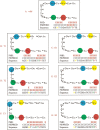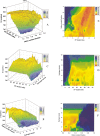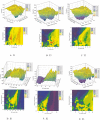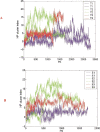Energy landscape and dynamics of the beta-hairpin G peptide and its isomers: Topology and sequences
- PMID: 12930988
- PMCID: PMC2323986
- DOI: 10.1110/ps.0306103
Energy landscape and dynamics of the beta-hairpin G peptide and its isomers: Topology and sequences
Abstract
We have investigated free energy landscape [MM/PBSA + normal modes entropy] of permutations in the G peptide (41-56) from the protein G B1 domain by studying six isomers corresponding to moving the hydrophobic cluster along the beta-strands (toward the turn: T1, AGEWTYDDKTFTVTET; T2, GEDTWDYATFTVTKTE; T3, GEDDWTYATFTVTKTE; toward the end: E1, WTYDDAGETKTFTVT; E2, WEYTGDDATKTETFTV; E3, WTYEGDDATKTETFTV). The free energy terms include molecular mechanics energy, Poisson-Boltzmann electrostatic solvation energy, surface area solvation energy, and conformational entropy estimated by using normal mode analysis. From the wild type to T1, then T3, and finally T2, we see a progressively changing energy landscape, toward a less stable beta-hairpin structure. Moving the hydrophobic cluster outside toward the end region causes a greater change in the energy landscape. alpha-Helical instead of a beta-hairpin structure was the most stable form for the E2 isomer. However, no matter how much the sequence changes, for all variants studied, ideal "native" beta-hairpin topologies remain as minima (regardless of whether global or local) in the energy landscape. In general, we find that the energy landscape is dependent on the hydrophobic cluster topology and on the sequence. Our present study indicates that the key is the relative conformational energies of the different conformations. Changes in the sequence strongly modulate the relative stabilities of topologically similar regions in the energy landscape, rather than redefine the topology space. This finding is consistent with a population redistribution in the process of protein folding. The limited variation of topological space, compared with the number of possible sequence changes, may relate to the observation that the number of known protein folds are far less than the sequential allowance.
Figures






Similar articles
-
Free energy surfaces of beta-hairpin and alpha-helical peptides generated by replica exchange molecular dynamics with the AGBNP implicit solvent model.Proteins. 2004 Aug 1;56(2):310-21. doi: 10.1002/prot.20104. Proteins. 2004. PMID: 15211514
-
Molecular dynamics simulations of a beta-hairpin fragment of protein G: balance between side-chain and backbone forces.J Mol Biol. 2000 Mar 3;296(4):1091-104. doi: 10.1006/jmbi.2000.3518. J Mol Biol. 2000. PMID: 10686106
-
Comparative study of generalized born models: Born radii and peptide folding.J Phys Chem B. 2005 Feb 24;109(7):3008-22. doi: 10.1021/jp046307s. J Phys Chem B. 2005. PMID: 16851315
-
[A turning point in the knowledge of the structure-function-activity relations of elastin].J Soc Biol. 2001;195(2):181-93. J Soc Biol. 2001. PMID: 11727705 Review. French.
-
beta-hairpin-forming peptides; models of early stages of protein folding.Biophys Chem. 2010 Sep;151(1-2):1-9. doi: 10.1016/j.bpc.2010.05.001. Epub 2010 May 6. Biophys Chem. 2010. PMID: 20494507 Free PMC article. Review.
Cited by
-
Kinetic Analysis of Guanidine Hydrochloride Inactivation of β-Galactosidase in the Presence of Galactose.Enzyme Res. 2012;2012:173831. doi: 10.1155/2012/173831. Epub 2012 Sep 13. Enzyme Res. 2012. PMID: 23008759 Free PMC article.
-
Pioneer in Molecular Biology: Conformational Ensembles in Molecular Recognition, Allostery, and Cell Function.J Mol Biol. 2025 Jun 1;437(11):169044. doi: 10.1016/j.jmb.2025.169044. Epub 2025 Feb 25. J Mol Biol. 2025. PMID: 40015370 Review.
-
The stability of monomeric intermediates controls amyloid formation: Abeta25-35 and its N27Q mutant.Biophys J. 2006 May 15;90(10):3365-74. doi: 10.1529/biophysj.105.075309. Epub 2006 Feb 24. Biophys J. 2006. PMID: 16500972 Free PMC article.
-
Understanding the key factors that control the rate of beta-hairpin folding.Proc Natl Acad Sci U S A. 2004 Nov 9;101(45):15915-20. doi: 10.1073/pnas.0405904101. Epub 2004 Nov 1. Proc Natl Acad Sci U S A. 2004. PMID: 15520391 Free PMC article.
References
-
- Baldwin, R.L. 1994. Matching speed and stability. Nature 369 183–184. - PubMed
-
- Blanco, F., Rivas, G., and Serrano, L. 1994. A short linear peptide that folds into a native stable β-hairpin in aqueous solution. Struct. Biol. 1 584–590. - PubMed
-
- Bozko, E.M. and Brooks III, C.L. 1995. First principles calculation of the folding free energy for a three helix bundle protein. Science 269 393–396. - PubMed
-
- Bryngelson, J.D. and Wolynes, P.G. 1989. Intermediates and barrier crossing in a random energy model (with applications to protein folding). J. Phys. Chem. 93 6902–6915.
Publication types
MeSH terms
Substances
Grants and funding
LinkOut - more resources
Full Text Sources

